
Launched in 2020 in partnership with the The National Society of Black Physicists (NSBP), the Innovate Seminar Series is a forum for NSBP members to share their research ideas and projects in a non-specialist way with a wide audience. The 30-minute talk (followed by 15 minutes of Q&A) will be a Zoom Webinar, and recorded. It will be available to the whole world soon after the event at KITP Online. Talks are also posted on the NSBP website https://nsbp.org/blogpost/1882533/Innovate-Seminar-Series
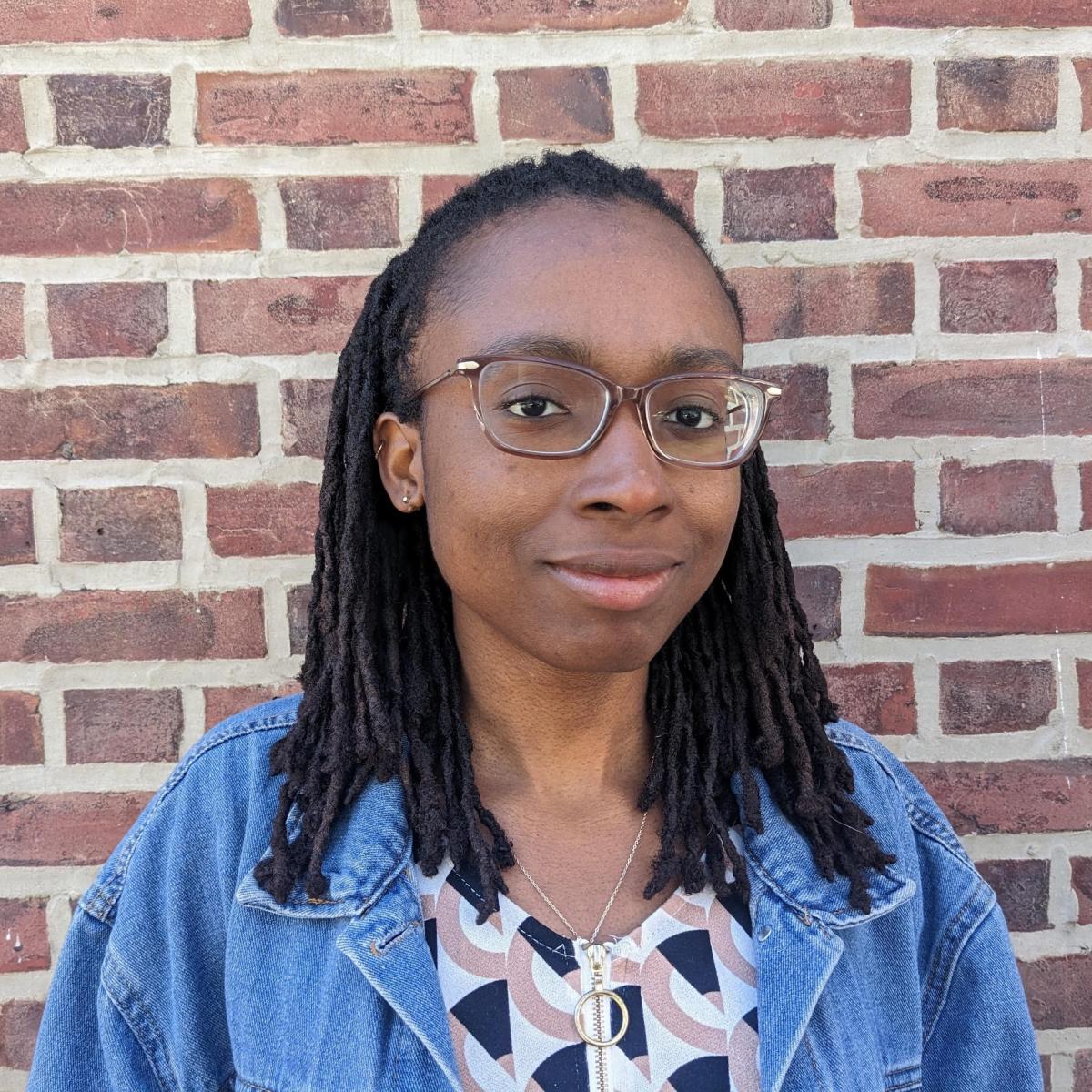
Ilenna Jones
Kempner Institute for the Study of Natural and Artificial Intelligence at HarvardQuantifying the impact of dendritic properties on neuronal computation.
In Systems Neuroscience, single neuron models can take many forms that can answer specific questions or fulfil a targeted purpose. However, model building is an underconstrained process that yields models that are often highly abstracted away from empirical reality. The point neuron assumption, where dendritic spatiotemporal properties and nonlinearities are assumed to be irrelevant, is a common simplification in neuronal and multineuronal models. Though these models can be useful for answering many questions, their use may bias investigations of higher-level function that pertains to how the nervous system computes. Constraining neuron model development with neural data has been historically challenging due to technological limitations and limited knowledge of what a priori assumptions to make. However, investigating how qualitative empirical properties impact a neuron model's ability to perform a normative goal has the potential to inform and constrain single neuron model selection. Using a supervised learning framework, we investigate which qualitative dendritic properties in single neuron models have the most impact on the normative goals of learning and computation at the single-neuron level. We find that the dendritic properties introduced could either limit and enable performance on a set of computer vision tasks that require complex computation. We observed that a synergy of all dendritic properties enabled performance above that of models with fewer or isolated properties. From this we conclude that single neurons may be enabled by their dendritic properties to learn and compute complex functions. This framework can be further used to identify which empirical properties are most relevant to the normative goal of complex computation. This also suggests that multineuronal models that are used to investigate neural computation should re-evaluate use of the point-neuron abstraction. This work emphasizes the need to connect normative goals to implementable empirical details in neuron modeling.About the Speaker
Ilenna Jones is a Research fellow at the Kempner Institute for the Study of Natural and Artificial Intelligence at Harvard. Her research interests include neuronal biophysics and computation, model optimization, and neuroscience for AI. She received her B.A. in Neuroscience in 2015 from Dartmouth College. In 2023 she received her PhD in Neuroscience at the University of Pennsylvania in Konrad Kording’s laboratory. Ilenna began her position as a Research Fellow in the Kempner Institute in 2023.Wednesday, March 27, 2024 at 2:00 PM ET

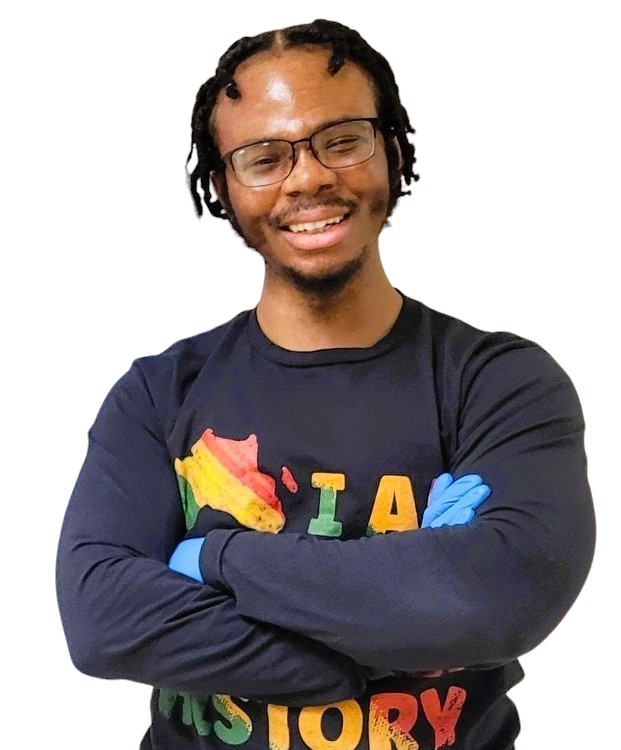
Hilary Utaegbulam
University of Rochester / Fermi LabReconstructing Charged Particle Interactions in Liquid Argon-like Neutrino Detectors: Liquid Argon Dead Region Interference Project (LArDRIP)
The 2x2 Demonstrator is a modular liquid argon time-projection chamber designed to serve as a prototype for the Near Detector of the Deep Underground Neutrino Experiment (DUNE). Like other neutrino detectors, the 2x2 has inactive regions wherein there is reduced or no sensitivity to charge deposition and light signals that arise from charged particle interactions with liquid argon. In the 2x2, these inactive regions are positioned in-between the active detector modules, which introduces the challenge of infering what charge signals ought to look like in these regions. The goal of this project is to train a machine learning model that uses an encoder-decoder architecture tailored for point cloud completion to learn to infer probable charge deposition configurations, given a mostly-complete point cloud. Some further goals of this project are to eventually produce a more detector-independent representation of charge particle tracks and to estimate the lost energy due to an inactive or dead region.About the Speaker
Hilary is a physics graduate student at the University of Rochester. He uses machine learning models to study neutrino physics as a member of the Deep Underground Neutrino Experiment (DUNE). Hilary is stationed at Fermi National Accelerator Laboratory (Fermilab) where he works on-site as a graduate physics researcher. Prior to joining the University of Rochester, Hilary earned his Bachelor's degree in Physics with a minor in Mathematics from the University of Houston.Hilary is a person who stutters and is also a stutter advocate. He works to leverage his position as a physics graduate student and his long-term position as a student and teacher in academia to create a more inclusive and supportive environment for people who stutter.
Wednesday, February 14, 2024 at 1:00 PM ET


Allen Pierre-Louis
Brookhaven National Laboratory & Stony Brook UniversityHigh Q^2 electron-proton elastic scattering at the future Electron-lon Collider
Unpolarized electron-proton elastic scattering cross-section measurements at high Q^2 allow for improved extractions of the proton electromagnetic form factors as well as provide constraints on possible hard two-photon exchange effects. We present a detailed study of the feasibility of making these high Q^2 e-p elastic measurements at the future Electron-Ion Collider (EIC). The results show that e-p elastic cross sections can be obtained in the momentum transfer range of 6 (GeV/c)2About the Speaker
Allen Pierre-Louis is a GEM fellow, Edward Bouchet fellow, Brookhaven National Laboratory staff researcher for the Center for Frontiers in Nuclear Science, and an MA student in Physics at Stony Brook University. Allen graduated from Stony Brook University with a B.S. in Physics and hopes to pursue a PhD in the subject.His research focuses on feasibility studies for the Electron Ion Collider to be built at Brookhaven and the construction of cosmic ray trackers and gas electron multipliers (GEM) detectors for the MOLLER experiment at Jefferson Laboratory. Allen is a recipient of the Brookhaven National Laboratory Augustus Prince Award. He is passionate about outreach and helped start the Stony Brook chapter of NSBP where he serves as the president. At the national level, Allen is also an NSBP student council member.
Wednesday, December 13, 2023 at 4:00 PM ET


Trevor GrandPre
Center for the Physics of Biological Function (CPBF) & Princeton Center for Theoretical Science (PCTS)Effects of linker length in Biomolecular Condensates
Biomolecular condensates are membraneless organelles formed through phase separation of macromolecules. These molecules typically consist of "sticker" regions that bind to one another connected by flexible "linker" regions. Linkers are believed to play multiple roles in condensates including filling space and adding interactions. I am currently addressing an understudied question, namely how linker length relative to other intrinsic molecular lengths affects phase separation. I'm focusing on the pyrenoid, a condensate that enhances the efficiency of photosynthesis in many green algae. The best-studied pyrenoid, that ofChlamydomonas reinhardtii, has two key components: the carbon-fixing enzyme Rubisco and EPYC1, an intrinsically disordered linker protein. To understand how EPYC1 linker length relative to Rubisco binding-site spacing affects condensation, I?ve employed both coarse-grained simulations and analytical theory. Strikingly, halving the EPYC1 linker lengths while keeping the number of stickers constant reduces critical concentrations by ten-fold. I explained this observation by introducing the concept of "molecular fit", i.e. the number of sticker bonds naturally formed between a pair of EPYC1 and Rubisco molecules. I've further explored this concept by varying the Rubisco binding-site locations. I found that the native binding-site locations yield the worst molecular fit, but are therefore optimal for phase separation. In addition, shorter linkers undergo a phase transition from a condensate to a gas of rods as Rubisco-binding sites are moved closer to the poles. These findings illustrate how intrinsically disordered proteins impact phase separation through the interplay of molecular length scales, and underscore the evolutionary pressures to optimize these lengths.About the Speaker
Trevor GrandPre is an alumnus of DePaul University and UC Berkeley where he earned his Bachelor's degree in Physics in 2014 and his PhD in 2021. Since 2021, he has been an independent postdoctoral fellow at the Center for the Physics of Biological Function (CPBF), and at the Princeton Center for Theoretical Science (PCTS), as well as a Schmidt Science Fellow.Monday, October 30, 2023 at 4:00 PM ET


Farrah Simpson
Brown UniversitySearch for the Vector-Like Quark, X5/3, at the Large Hadron Collider
Abstract: The discovery of the Higgs boson by both the CMS and ATLAS experiments marked a historic moment for the Large Hadron Collider because it confirmed the predictions of the Standard Model of particle physics. Since then, large efforts have been made to understand the properties of the Higgs boson. However, there are still many unanswered questions in the current theoretical framework of the Standard Model, such as the hierarchy problem. Several Beyond Standard Model theories that attempt to address these questions predict the existence of vector-like quarks. In this talk, I will present the search for a vector-like quark, the X5/3. It is a strongly interacting fermionic partner of the top quark with an exotic charge +5/3. The search is conducted using CMS Run 2 datasets for events with the pair production of an X5/3 and its antiparticle which subsequently decay to a top quark and a W boson. The search is also conducted for a new decay chain where the X5/3 is allowed to decay to BSM particles. To enhance signal-to-background separation, the search is constructed for events with only one lepton in the final state to achieve unprecedented sensitivities.About the Speaker
Farrah Simpson is a rising sixth year physics PhD candidate at Brown University. She conducts research in high energy experimental physics with the Compact Muon Solenoid (CMS) Collaboration at the Large Hadron Collider (LHC). Her research focuses on Beyond Standard Model physics searches for Vector-Like Quarks. She also performs methods of sensor quality control for the detector upgrades for the High Luminosity LHC. Farrah hails from the island of Jamaica and completed her undergraduate degree in Applied Physics at Columbia University. She is passionate about teaching, mentoring and advocating for historically underrepresented groups in STEM. She serves as a DEI committee member for CMS and the immediate Past Student Representative on the Executive Board of the National Society of Black Physicists. She spent the past year at Fermilab as an LHC Physics Center Graduate Scholar.Tuesday, August 29, 2023 at 4:00 PM ET

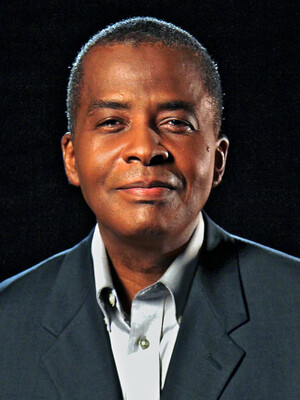
Keith Baker
D. Allan Bromley Professor of Physics at Yale UniversityQuantum Entanglement in Higgs Boson Decays to Vector Bosons
Abstract: A presentation will be given on Monte Carlo results and spectra of (1) quantum entanglement, (2) Bell's Inequality violation, and (3) entanglement entropy in Higgs boson decays ttot ZZ* bosons at LHC energies.About the Speaker
Professor Keith Baker concentrates on experimental particle physics, including research at the energy frontier being conducted by the ATLAS collaboration at the Large Hadron Collider (LHC), the world’s largest and most powerful particle accelerator, in Geneva, Switzerland, and precision studies at sub-eV energies. He helped build the detectors and was part of the team that carried out the machine learning analysis in the discovery of the Higgs boson, the last elementary particle predicted in what is known as the Standard Model of particle physics.His current research topics include quantum information science in high energy physics, electroweak symmetry breaking, and experiments that test the boundaries of the standard model of physics.
Baker has received numerous awards and honors, including the Edward Bouchet Award from the American Physical Society, in 2002, for “his contribution to nuclear and particle physics; for building the infrastructure to do these measurements; and for being active in outreach activities, both locally and nationally.” He was also the recipient of the Elmer Imes Award for Outstanding Research by the National Society of Black Physicists and the National Conference of Black Physics Students. He has also received the E. L. Hamm Sr. Distinguished Teaching Award and the National Award for Teaching Learning and Technology. In 2017, he was honored as a U.S. ATLAS Distinguished Researcher.
He is a graduate of Massachusetts Institute of Technology, where he earned a B.S. in physics, and Stanford University, where he earned an M.S. in both physics and mathematics, in 1983, and then his Ph.D., in physics, in 1987. In 1989, he was appointed staff scientist at the Thomas Jefferson National Accelerator Facility in Virginia and associate professor at Hampton University. Since 2006 he has been a professor of physics at Yale. He is also former director of the Yale Wright Laboratory.
Thursday, June 29, 2023 at 4:00 PM ET

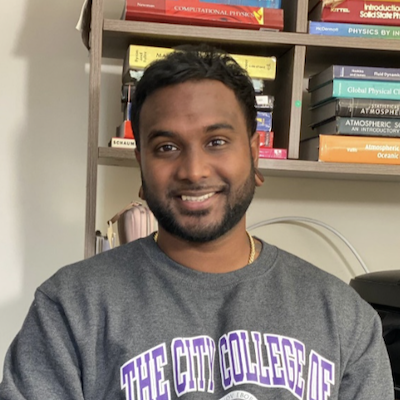
Veeshan "Vee" Narinesingh
Postdoctoral Researcher at Princeton University / NOAA Geophysical Fluid Dynamics LaboratoryA Physicist's Guide to Weather and Climate Science
Abstract: Thermodynamic and dynamical aspects of geophysical fluids are key to generating the everyday weather that we experience, as well as what the climate will be like in years to come. In this talk we will first review fundamental aspects of earth's atmospheric circulation, and how computer simulations are used as experimental playgrounds to understand climate. Then, background and original research will be presented on atmospheric blocking: persistent extratropical anticyclones known to steer storms and generate devastating heatwaves and cold spells. This work includes climate modeling experiments performed at NOAA Geophysical Fluid Dynamics Laboratory studying blocking in current, "future", and various hypothetical climates. Commentary will also be provided on routes into climate science from the point of view of someone fully trained in traditional physics.Special Remarks from Dr. V. Ramawamy, Director of NOAA Geophysical Fluid Dynamics Laboratory, will also be added.
About the Speaker
Veeshan "Vee" Narinesingh is a physicist who utilizes computer programming and mathematics to study the physics of weather, climate, and climate change. Vee completed his B.S. and Ph.D. in Physics at The City University of New York (CUNY). He currently is a Postdoctoral Researcher at the cooperative institute between Princeton University and NOAA Geophysical Fluid Dynamics Laboratory. Vee is a born and raised New Yorker whose parents immigrated from the island of Trinidad. He has very strong passions towards diversity, equity, and inclusion within STEM spaces. He also currently serves as the Director of Community Outreach for the Harlem Gallery of Science (HGS) and is a founding Mentor Leader of the NSBP and HGS Mentoring Program which serves adolescents in Harlem, New York City.Wednesday, May 3, 2023 at 4:00 PM ET


Bryan J Ramson
Associate Scientist at Neutrino Division, FermilabReviewing the Physics Program of the Fermilab Modern Modular Bubble Chamber
Long-baseline neutrino oscillation experiments present some of the most compelling paths towards beyond-the-standard-model physics through measurement of PMNS matrix elements and observation of the degree of leptonic CP violation. State-of-the-art long-baseline oscillation experiments, like NOvA and T2K, are currently statistically limited, however uncertainty in neutrino-nucleus scattering represents an important source of systematic uncertainty in future experiments like DUNE and Hyper-Kamiokande. Neutrino cross-section uncertainties can be reduced through high-statistics measurement of neutrino interactions on light nuclei, but creating a detector with an appropriate light target has proved elusive since the hydrogen bubble chambers designed in the 70’s. Modern bubble chamber-based dark matter detectors like PICO and the Scintillating Bubble Chamber have demonstrated that advances in sensor technology, computing, and automation would allow a modern bubble chamber to fully utilize the megawatt scale intensity LBNF beam. This talk will review the broad physics program and the construction of a hydrogen bubble chamber for use with neutrinos at Fermilab.About the Speaker
Bryan Ramson is a neutrino physicist working on the intensity frontier of high-energy particle physics. He works as an associate scientist at Fermilab, where he uses his expertise in medium and high-energy nuclear physics to improve measurements of neutrino oscillations and refine our understanding of neutrino-nucleus interactions. He is a member of two large experimental collaborations: the Fermilab NuMI Off-axis νe Appearance (NOvA) Experiment and the upcoming Deep Underground Neutrino Experiment (DUNE), a future Fermilab experiment. When not directly supporting the measurement of neutrino oscillations, he studies neutrino-nucleus interactions in the NOvA Near Detector and leads an independent R&D project to develop a new generation of hydrogen bubble chambers. Bryan earned dual B.S.’s in Physics and Mathematics, and an M.S. in Atmospheric Sciences from Howard University in Washington, DC. He earned another M.S. and Ph.D. in Applied Physics from the University of Michigan, Ann Arbor. His doctoral work concerned the study of nuclear anti-matter and occurred as a visiting scholar on the Argonne/Fermilab high-energy nuclear/particle physics experiment, E906/SeaQuest.Bryan has a strong commitment to serving society scientifically, as well as socially. Before matriculating at Michigan he was a visiting scholar at Earth Sciences Division of NASA Goddard from Howard University, working primarily on the measurement of cloud properties in the Baltimore-Washington corridor and the US Southern Great Plains region. He currently serves as the co-Chair of the Fermilab Saturday Morning Physics program and has engaged in various forms of community engagement around the Chicagoland area especially as it concerns science outreach and local community organizing.
Bryan is a native of New Orleans, LA, coming of age in the Seventh and Ninth Wards of the city. He currently resides in the West Garfield Park neighborhood on the West Side of Chicago, Illinois. When he is not thinking about quarks and leptons or actively working for a better future, he enjoys popular television and movies, speculative fiction, exercise, performance driving, and video games.
Friday, February 24, 2023 at 3:00 PM ET
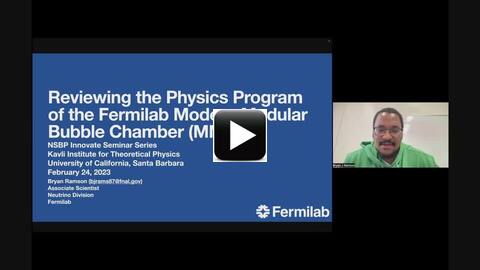
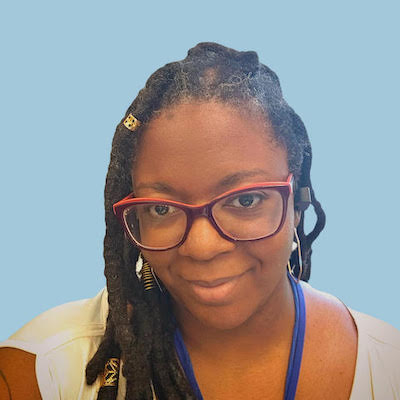
LaToya Anderson
Associate Research Analyst at the Simons Foundation and a physics undergraduate at Brooklyn CollegeExploring Super Atomic Crystals
Super atomic crystals offer an exciting opportunity to improve materials used in technological devices including solar panels, lithium-ion batteries, and quantum computing hardware. By studying their properties, we can explore their design complexity and offer insights into their potential functionality to engineers who then have the challenge of building these materials. In my talk, I will answer these questions: What is a super atomic crystal? How do we use computational materials science techniques to discover their properties? And how can these properties potentially improve certain technologies?About the Speaker
LaToya Anderson is an Associate Research Analyst at the Simons Foundation and a physics undergraduate at Brooklyn College.Tuesday, November 29, 2022 at 3:00 PM ET

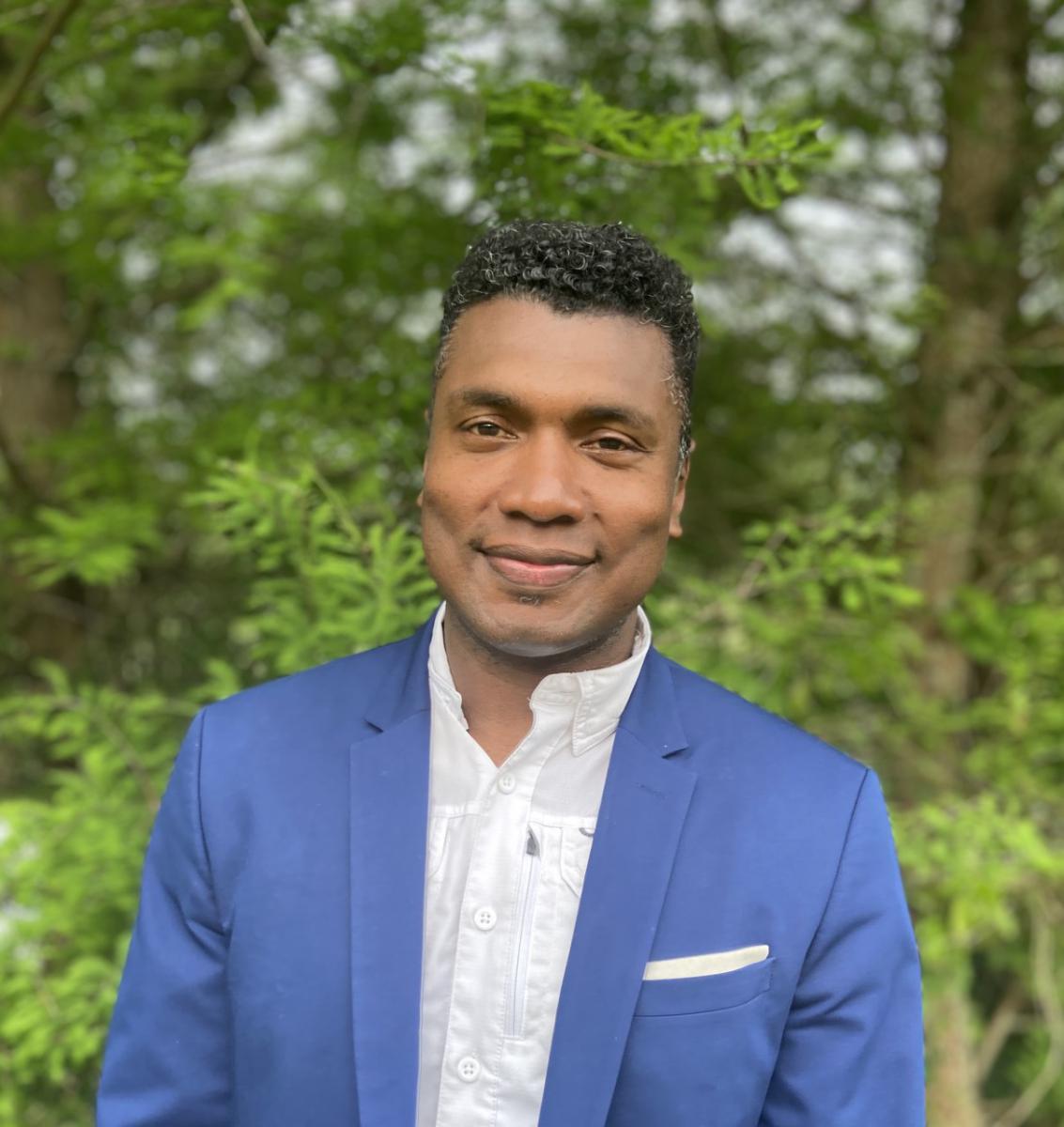
Stephon Alexander
Professor at Brown UniversityThe Chiral Universe
Among a handful of mysteries in the LambdaCDM paradigm of cosmology, I focus on three: Dark Matter, Baryogenesis and the origin of structure. I then provide a pedagogical introduction to Chiral Gravity and show how these three mysteries may be interconnected. I also discuss some observational windows including the inevitability of parity violation in galaxy distributions.
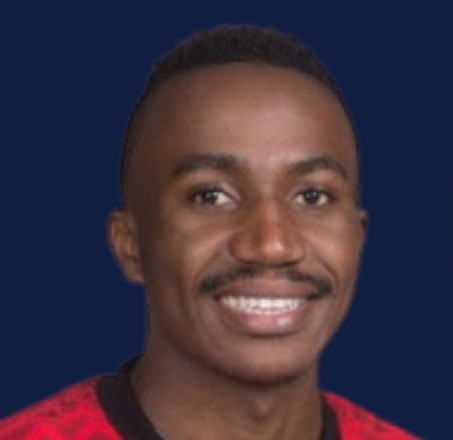
Christian Aganze
Grad student at UC San DiegoUltracool Dwarfs as Tracers for Galactic Structure and Star Formation History: Prospects with Large-Scale Surveys
Ultracool dwarfs (UCDs) are low-temperature stars and brown dwarfs with masses < 0.1 solar masses. These objects comprise > 20% of all stars in the Milky Way, and they have long lifetimes (>1 trillion years). As brown dwarfs do not fuse hydrogen, they cool down with time. This cooling provides an additional age tracer that can be exploited to characterize various galactic environments such as globular clusters. Additionally, spectral energy distributions of UCDs display strong molecular features that are sensitive to chemical abundance effects; and UCDs preserve the initial chemistry of their progenitor molecular clouds. As such, UCDs serve as unique probes of the structure, formation, and evolution of the Milky Way System. However, because of their low luminosities, UCD samples have been limited to the local volume (d < 100 pc) and have remained under-utilized as tracers for galactic structure. Deep imaging and spectroscopic surveys, particularly with space-based telescopes, provide an opportunity to find distant brown dwarfs out to >1 kpc. In this talk, I present my work on finding distant ultracool dwarfs in two HST/WFC3 parallel surveys, WISPS & 3D-HST. I demonstrate how machine learning techniques provide more robust selection than traditional index-based methods in deep spectroscopic samples, and present a sample of 164 late-M, L and T dwarfs extending to 2 kpc. With this sample, I measured population scaleheights and ages as a function of spectral class using a Monte-Carlo simulation framework that accounts for the stellar mass function, star formation history, UCD evolutionary models, galactic structure, and survey properties and selection functions. I confirm that thin disk L dwarfs are younger than late-M dwarfs due to brown dwarf cooling. I also apply this modeling technique to predict that the next generation of deep and wide-field observatories, including JWST, the Nancy Grace Roman Telescope, the Vera Rubin Observatory, Euclid, and SPHEReX, will uncover millions of UCDs throughout various environments in the Galaxy, opening up a new era for understanding the history of the Milky Way.About the Speaker
Christian is a final-year graduate student at UC San Diego and a graduate of Morehouse College. He studies properties of low-mass stars and brown dwarfs and how they can be leveraged to understand the formation and the history of the Milky Way. He is also interested in detecting gaps in globular cluster streams as potential avenues for testing dark matter models. He is a recent winner of the NBSP Beth Brown Memorial Award.Thursday, September 22, 2022 at 7:00 PM ET

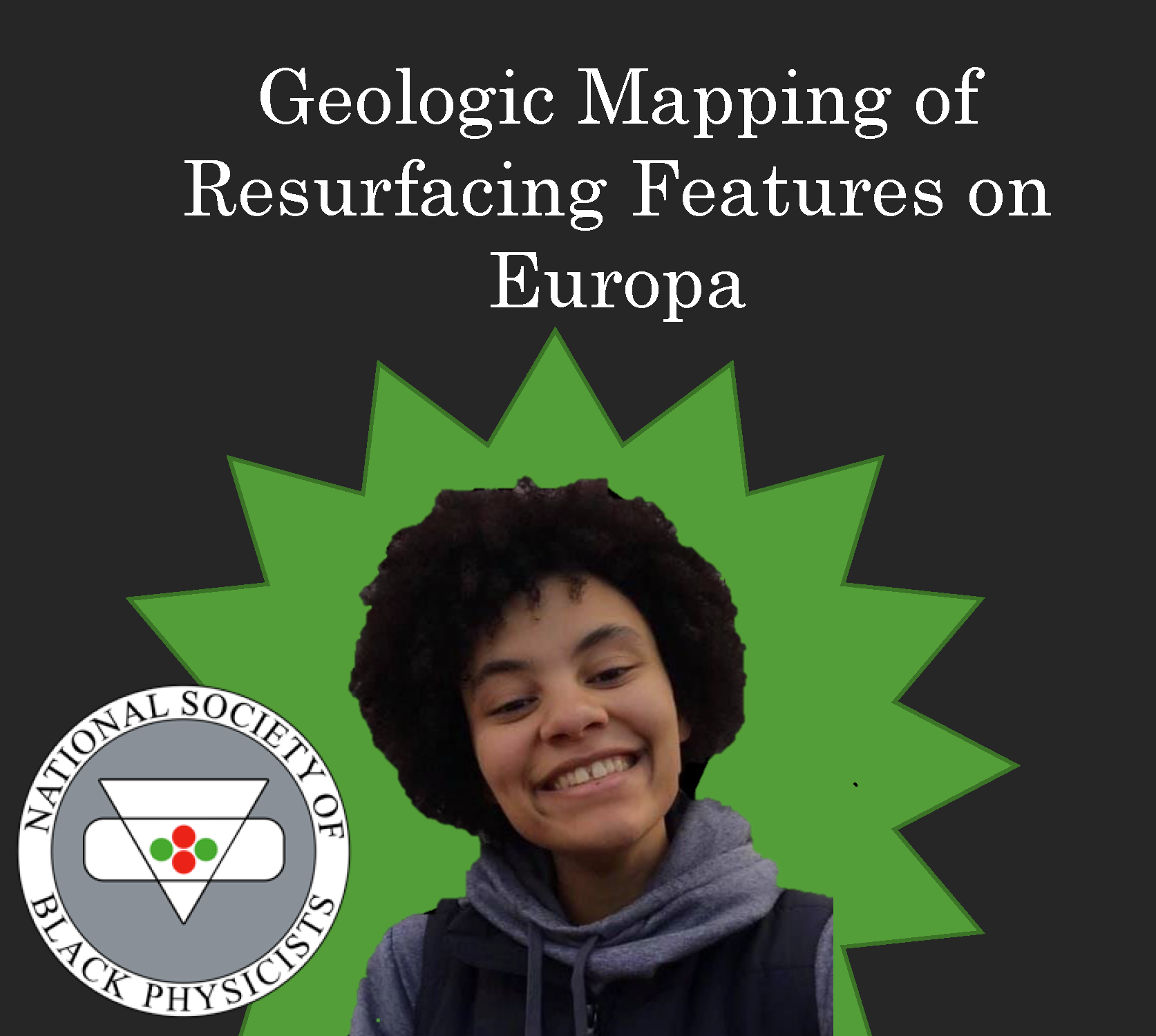
Kierra Wilk
1st year PhD student at Brown UniversityGeologic Mapping of Resurfacing Features on Europa
There is ample evidence to suggest that Jupiter’s moon Europa is geologically active, with previous investigations suggesting that a subset of domical features on the icy moon may be cryovolcanic in origin. Cryovolcanism, the eruption of water phases or other aqueous solutions that would otherwise be frozen solid at the normal temperature of an icy satellite’s surface, has likely played a role in the resurfacing of Europa in recent geologic time. Although several of these domes have been classified as extrusive cryovolcanic domes, they have not been extensively investigated, warranting a re-examination of cryolava domes on Europa. Here we mapped domical features characterized by their lobate shape and relatively smooth surfaces. These domes are distinct from the surrounding terrain and have been interpreted to have formed via the axisymmetric flow of viscous fluids onto Europa’s surface. Pinpointing the spatial distribution of these domes and their geologic context will provide insights into regions of recent geological activity on Europa and into Europa’s cryovolcanic evolution.About the Speaker
Kierra Wilk is a 1st year PhD student at Brown University in the Department of Earth, Environmental, and Planetary Sciences. Prior to her graduate studies, Kierra received her Bachelor of Science in Geology with a minor in Astrobiology from Rensselaer Polytechnic Institute.Friday, February 4, 2022 at 5:30 PM ET

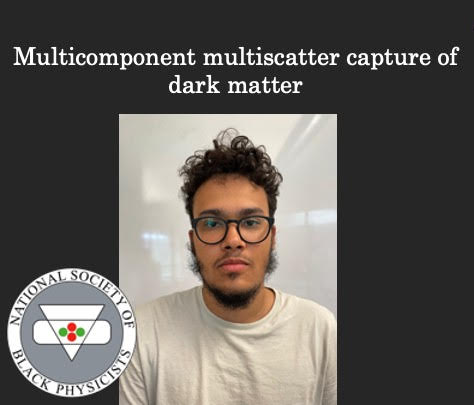
Caleb Levy
Junior Physics Student at Colgate UniversityMulticomponent multiscatter capture of dark matter
In recent years, the usefulness of astrophysical objects as dark matter (DM) probes has become more and more evident, especially in view of null results from direct-detection and particle-production experiments. The potentially observable signatures of DM gravitationally trapped inside a star, or another compact astrophysical object, have been used to forecast stringent constraints on the nucleon–dark matter interaction cross section. Currently, the probes of interest are at high redshifts, Population III (Pop III) stars that form in isolation or in small numbers, in very dense DM minihalos at z ∼ 15–40, and, in our own Milky Way, neutron stars, white dwarfs, brown dwarfs, exoplanets, etc. None of these objects are truly single component and, as such, capture rates calculated with the common assumption made in the literature of single-component capture, i.e., capture of DM by multiple scatterings with one single type of nucleus inside the object, are not accurate. In this paper, we present an extension of this formalism to multicomponent objects and apply it to Pop III stars, thereby investigating the role of He in the capture rates of Pop III stars. As expected, we find that the inclusion of the heavier He nuclei leads to an enhancement of the overall capture rates, further improving the potential of Pop III stars as dark matter probes.About the Speaker
Caleb Levy is a junior physics student at Colgate University who was born and raised in Kingston, Jamaica. Caleb currently works with Dr. Cosmin Ilie at Colgate on dark matter phenomenology in astrophysical objects and hope to study theoretical cosmology and particle theory after graduation. Caleb is also an avid music lover (currently learning Jazz piano), amateur tennis enthusiast, and lover of dogs!Wednesday, December 1, 2021 at 5:30 PM ET

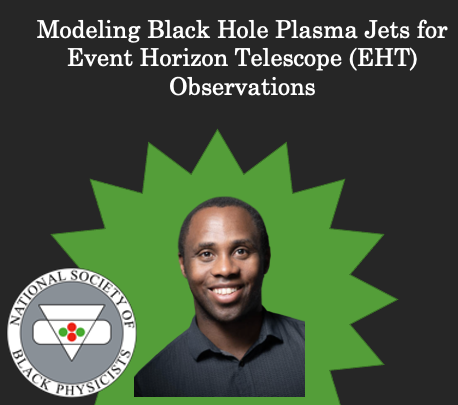
Richard Anantua
Center for Astrophysics | Harvard & Smithsonian and Black Hole Initiative at HarvardTowards Event Horizon Scale Physics from Movies and Polarization Maps
Recent radio observations of inflowing and outflowing plasma in the vicinity of supermassive black holes are linked to plasma physics models via simulations through a methodology called “Observing” Jet/Accretion flow/Black hole (JAB) Systems. For M87, HARM jet simulations are viewed from Very Large Array (43 GHz) to Event Horizon Telescope (230 GHz) scales to replicate the observed collimation and magnetic field configuration, while serving as the basis for a semi-analytic model used to generate polarization maps and spectra. This model varies plasma content from ionic (e-p) to pair (e-e+). Emission at the observed frequency is assumed to be synchrotron radiation from electrons and positrons, whose pressure is set to relate to the local magnetic pressure through parametric prescriptions. Polarization maps and spectra are found to be observationally distinguishable through positron effects such as decreasing intrinsic circular polarization and Faraday conversion. For Sagittarius A* in our Galactic Center, we include a turbulent heating electron temperature model. Intensity map movies simulating hourly timescales show that these models can be classified into at least four types: 1.) thin, asymmetric photon ring with best fit spectrum; 2.) coronal boundary layer with thin photon ring and steep spectrum; 3.) thick photon torus with flat spectrum; and 4.) extended outflow with flat spectrum. These models may be distinguishable by the Event Horizon Telescope.About the Speaker
Dr. Richard Anantua is a postdoctoral fellow at the Center for Astrophysics | Harvard & Smithsonian and Black Hole Initiative at Harvard. As a member of the Event Horizon Telescope Collaboration, Richard coordinates the Outreach Group and links observational features of near-horizon shadows of supermassive black holes to the plasma physics of nearby accretion disks and jets which light them up. Prior to Harvard, Richard held a postdoctoral/instructor position at U.C. Berkeley after completing his Ph.D. in Physics at Stanford under Prof. Roger Blandford and a B.S. from Yale in (Physics & Philosophy) and (Economics & Mathematics).Friday, October 22, 2021 at 5:30 PM EDT

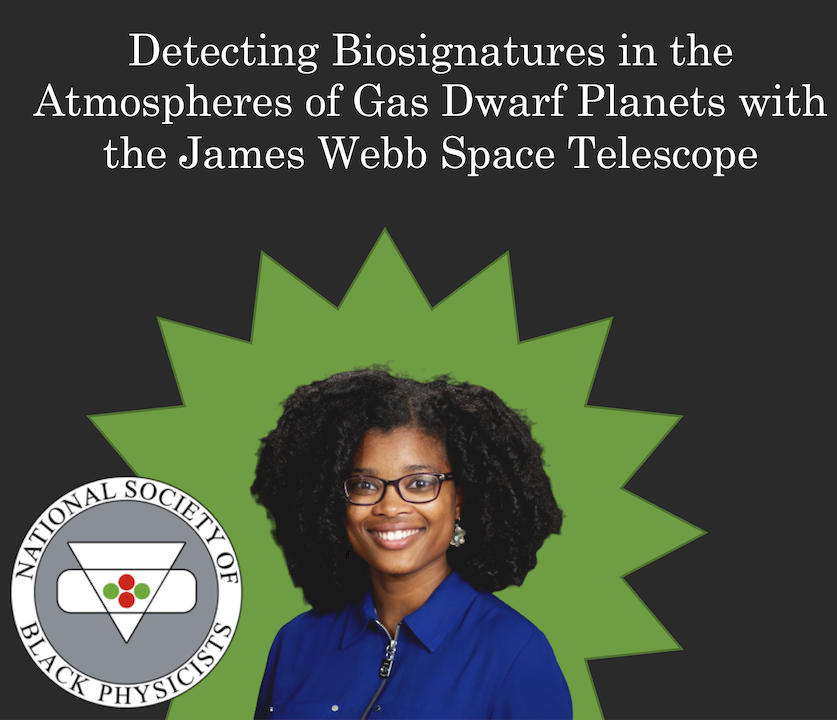
Caprice Phillips
PhD student at The Ohio State UniversityDetecting Biosignatures in the Atmospheres of Gas Dwarf Planets with the James Webb Space Telescope
Exoplanets with radii between those of Earth and Neptune have stronger surface gravity than Earth, can retain a sizable hydrogen-dominated atmosphere. In contrast to gas giant planets, we call these planets gas dwarf planets. The James Webb Space Telescope (JWST) will offer unprecedented insight into these planets. Here, we investigate the detectability of ammonia (NH3, a potential biosignature) in the atmospheres of seven temperate gas dwarf planets using various JWST instruments. We use petitRADTRANS and PandExo to model planet atmospheres and simulate JWST observations under different scenarios by varying cloud conditions, mean molecular weights (MMWs), and NH3 mixing ratios. A metric is defined to quantify detection significance and provide a ranked list for JWST observations in search of biosignatures in gas dwarf planets. In this talk, I will show that it is very challenging to search for the 10.3-10.8 micron NH3 feature using eclipse spectroscopy with MIRI in the presence of photon and a systemic noise floor of 12.6 ppm for 10 eclipses. NIRISS, NIRSpec, and MIRI are feasible for transmission spectroscopy to detect NH3 features from 1.5 to 6.1 microns under optimal conditions such as a clear atmosphere and low MMWs for a number of gas dwarf planets. In this talk, I will show that searching for potential biosignatures such as NH3 is feasible with a reasonable investment of JWST time for gas dwarf planets given optimal atmospheric conditions.About the Speaker
Caprice Phillips is a third year PhD student at The Ohio State University working with Dr. Ji Wang in the Department of Astronomy. Her research involves the detectability of potential biosignatures in the atmospheres of gas dwarf exoplanets with upcoming telescopes like JWST and Twinkle.Thursday, September 30, 2021 at 5:30 PM EDT

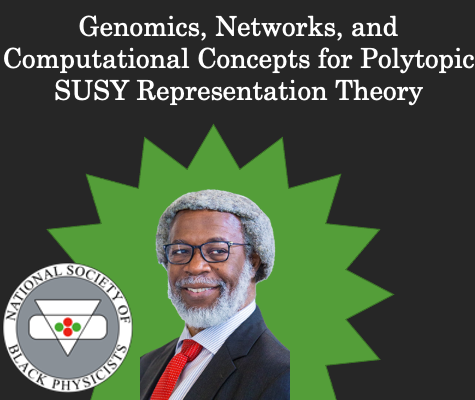
Dr. Sylvester James Gates
Ford Foundation Physics Professor & Affiliate Professor of Mathematics at Brown UniversityGenomics, Networks, And Computational Concepts For Polytopic SUSY Representation Theory
The mathematical topic of Supersymmetry (SUSY) is about a half century old. Yet, it still holds unsolved mysteries. Gell-Mann's 'Eight-fold Way' diagrams opened the door of discovery for the Standard Model. The analogous diagrammatic structures for SUSY are poorly understood and only now starting to be revealed. This search is presented in this talk.Tuesday, August 31, 2021 at 5:30 PM EDT

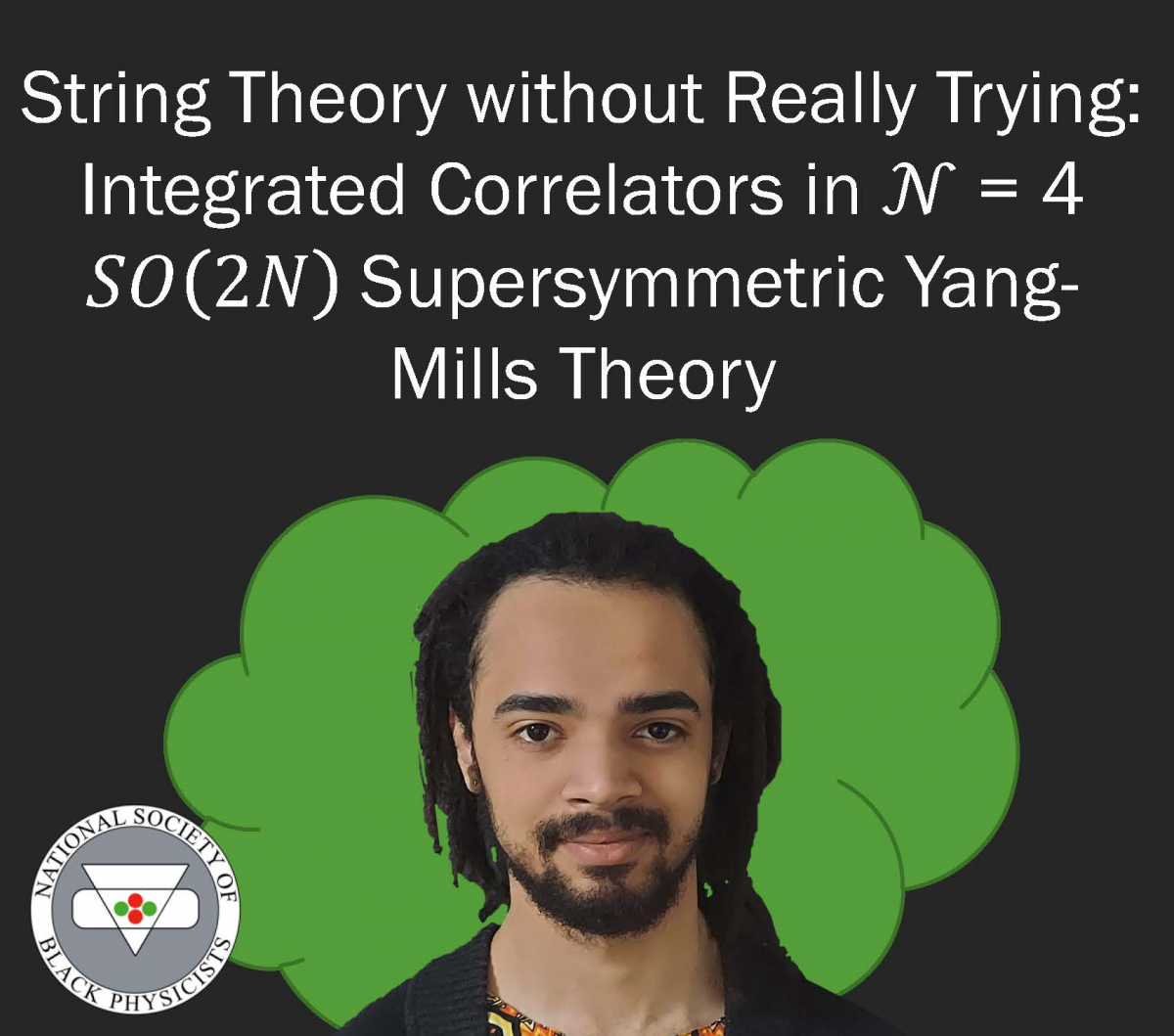
Nico Cooper
Graduate Student at NorthwesternString Theory without Really Trying: Integrated Correlators in N=4 SO(2N) Supersymmetric Yang-Mills Theory
Outside of theoretical physics, it's hard to really understand the buzz around string theory and supersymmetry. In the past couple of decades, we've gotten quite a bit of mileage through the framework of holography, namely the Anti de Sitter/Conformal Field Theory (AdS/CFT) correspondence, where a theory of quantum gravity can be described by a purely quantum theory on its boundary. I don't know very much at all about the details of string theory, but I do know how to compute quantities in certain conformal field theories, so the audience is in luck: we will set out to compute quantities in string theory only with the conformal field theory on the boundary, so we won't need to know a thing about string theory. Specifically, we will compute integrated correlators in N=4 SO(2N) Super-Yang-Mills theory, which correspond to scattering amplitudes in the bulk supergravity theory. This is a pretty overkill method as far as ordinary quantum field theories are concerned, so we'll also see how supersymmetry can be a powerful tool for theories like QCD, which describes the strong nuclear force.About the Speaker
Nico Cooper is a recent graduate of Princeton University, and currently a graduate student in math at Northwestern. His research has focused broadly on high energy theoretical physics, and superconformal field theories, and he has worked as a black queer activist in many capacities, recently as a member of the NSBP Student Council.Wednesday, June 30, 2021 at 5:30 PM EDT

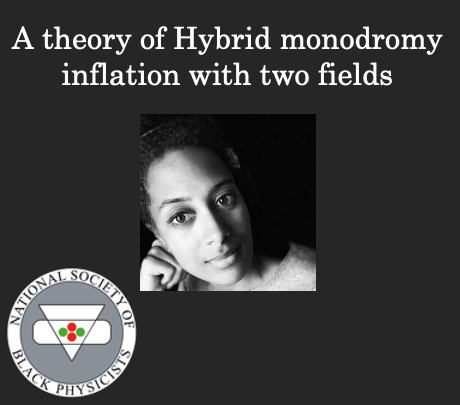
Morgane König
PhD Candidate at University of California, DavisA theory of Hybrid monodromy inflation with two fields
In this talk I will revisit the hybrid inflation theory first proposed by A.Linde.In his original paper, A.Linde considers an inflationary model involving two coupled massive scalar fields. This theory fails to predict a spectral index coherent with the Planck data. I will focus on a model developed by Stewart that allows for a viable spectral tilt that fits the current data.
We will see that we can study this hybrid inflation as an effective field theory showing that its predictions agree with the Planck data. Furthermore, I will explore the quantum stability of this model and outline a possible mechanism realizing the scalars as compact axions dual to massive 4-forms.
About the Speaker
Morgane König is a sixth year PhD candidate at the University of California, Davis, whose work focuses on particle physics, cosmology and gravity theory. Upon graduation, König will be the 9th black woman to receive a PhD in theoretical physics in the USA, and the first black student to get a PhD in physics at UC Davis. König was born and raised in Paris, France where she studied the piano, classical music theory, and ballet for 10 years at the conservatoire du 5eme arrondissement. More about Morgane König at: https://morganekonig.carrd.co/.Thursday, April 29, 2021 at 4:00 PM EDT

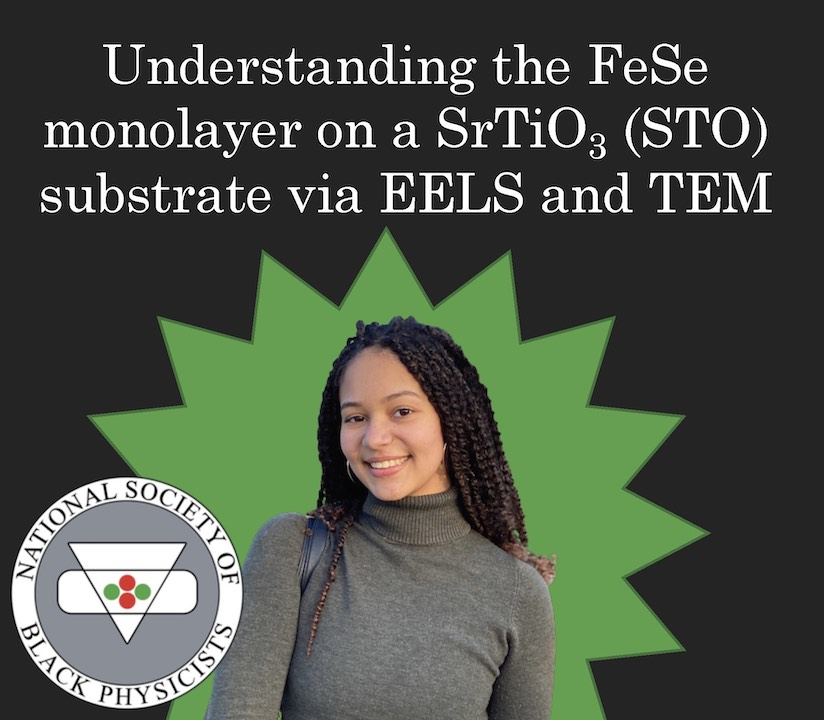
Samantha O’Sullivan
Junior undergraduate student at Harvard UniversitySe diffusion into SrTiO3 substrate in monolayer FeSe/SrTiO3
Monolayer FeSe on a SrTiO3 (STO) substrate is a high-temperature superconductor with reported Tc as high as 100 K, but the mechanism for such enhanced Tc remains poorly understood. Samantha's research characterizes the atomic structural and chemical composition of the FeSe/STO interface using transmission electron microscopy (TEM) and electron energy loss spectroscopy (EELS). These measurements reveal the presence of selenium in the top layers of STO, located on interstitial sites and in the TiO2 layers. We support our measurement with density functional theory (DFT) calculations. We discuss implications of our findings on substrate-induced electron doping in the FeSe/STO heterostructure.About the Speaker
Samantha O’Sullivan is a Junior undergraduate student at Harvard University concentrating in Physics and African-American Studies. She currently conducts research in experimental condensed matter physics at Harvard with a focus in electron microscopy of high temperature superconductors. She recently presented her research at the 2021 APS March Meeting and at NSBP's 2020 Annual Conference, where she won the award for "Best Talk in Condensed Matter". Outside of condensed matter Samantha is interested in plasma physics, and she will join Princeton's Plasma Physics Laboratory this summer to investigate tokamak edge physics. In her free time, Samantha enjoys genealogy research, running, and poetry.Monday, March 29, 2021 at 5:30 PM EDT

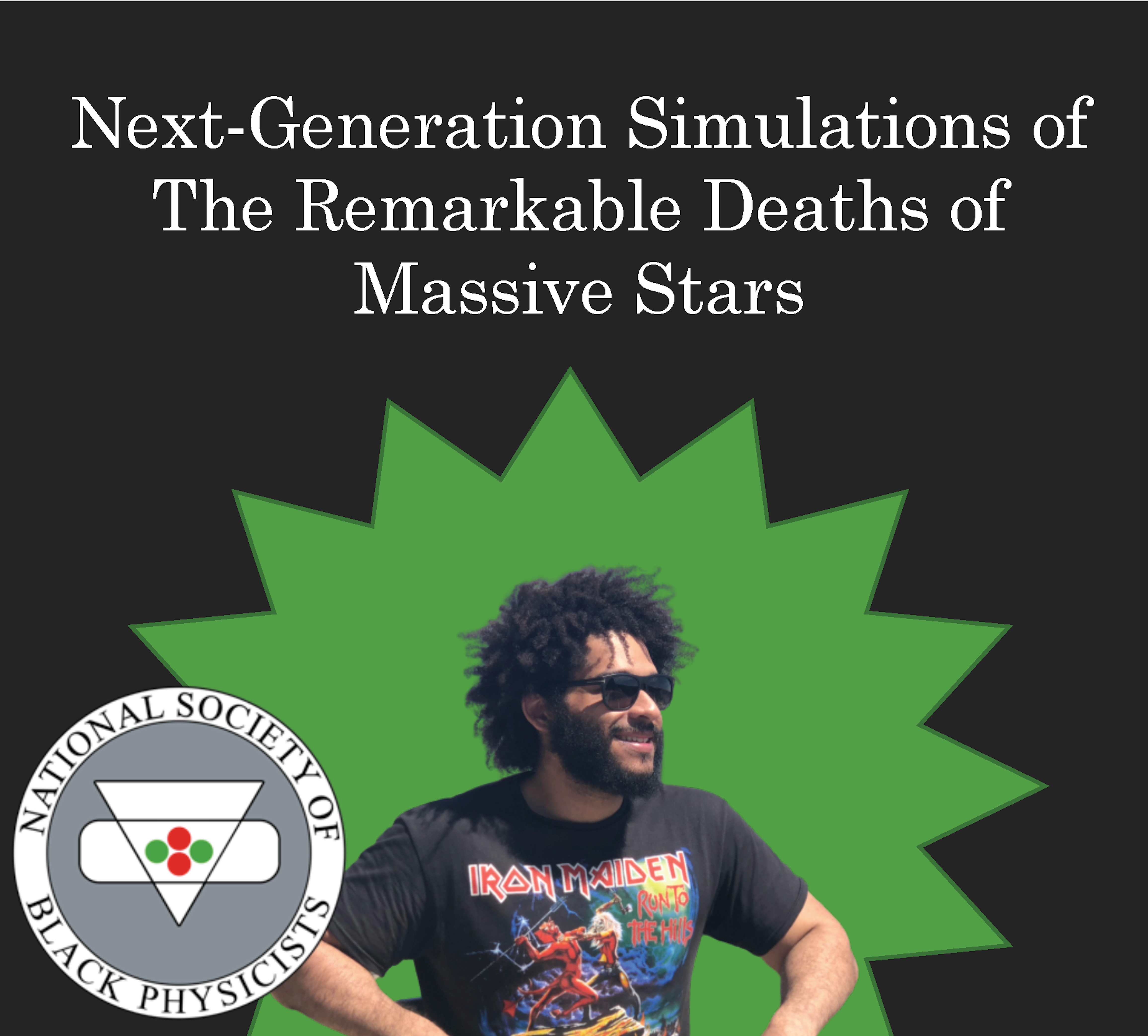
Carl E. Fields
Department of Physics & Astronomy at Michigan State UniversityNext-Generation Simulations of The Remarkable Deaths of Massive Stars
Core-collapse supernova explosions (CCSN) are one possible fate of a massive star. Simulations of CCSNe rely on the properties of the massive star at core-collapse. As such, a critical component is the realization of realistic initial conditions. Multidimensional progenitor models can enable us to capture the chaotic nuclear shell burning occurring deep within the stellar interior. I will discuss ongoing efforts to progress our understanding of the nature of massive stars through next-generation hydrodynamic stellar models. In particular, I will present recent results of three-dimensional hydrodynamic models of massive stars evolved for the final moments before collapse. These recent results suggest that realistic 3D progenitor models can be favorable for obtaining robust models of CCSN explosions and are an important aspect of massive star explosions that must be taken into consideration. I will conclude with a brief discussion of the implications our models have for predication of multi-messenger signals from CCSNe.About the Speaker
Carl E. Fields is a Ph.D. Candidate in the Department of Physics & Astronomy at Michigan State University working with Prof. Sean Couch. Carl's research focusses on astrophysical sources of gravitational waves, stellar nucleosynthesis, and multi-dimensional simulations of core-collapse supernova explosions and their massive star progenitors. Carl is jointly supported by the National Science Foundation and Los Alamos National Laboratory. Carl received his undergraduate degrees in Physics and Earth & Space Exploration (Astrophysics) where he worked with Prof. Frank Timmes. In 2020, Fields was award the Price Prize by Ohio State University and named to the Forbes 2021 Class of 30 under 30 for Science.Wednesday, January 27, 2021 at 5:30 PM EST

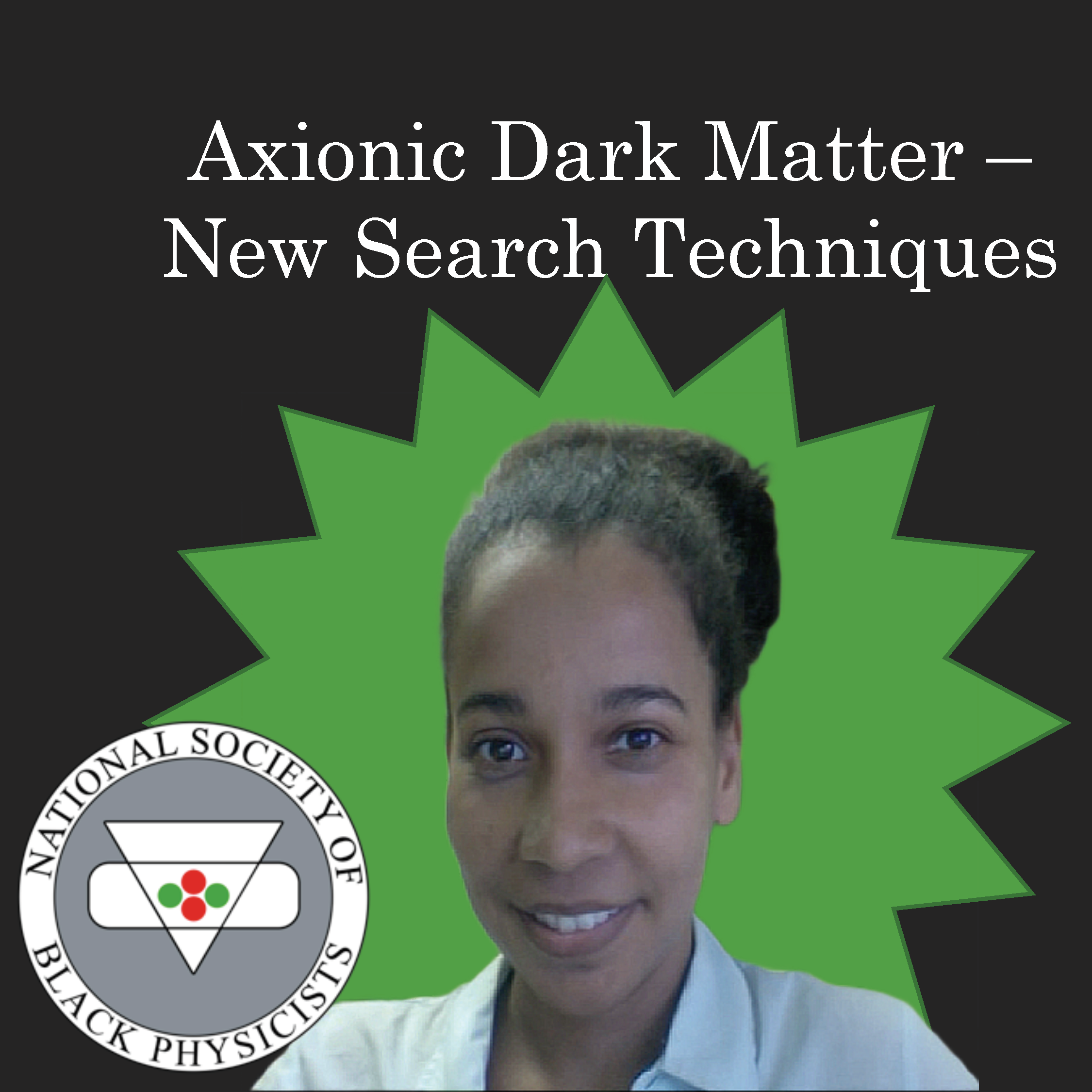
Dr. Carol Y. Scarlett
Assistant Professor, Department of Physics at Florida A&M UniversityAxionic Dark Matter – New Search Techniques
It is well known that a light, pseudo-scalar particle called the Axion can solve several fundamental physics problems. Proposed to explain the lack of a neutron EDM, such a weakly interacting particle has the right characteristics to explain formation of galaxies, by providing the needed mass in the form of Cold Dark Matter. Additionally, there has been data collected on the decay of several radioactive nuclei suggesting the need for weakly interacting particles streaming from the sun and throughout the galaxy. This talk will review the theory behind axion particles, examples of early experimental searches and some new search techniques. The nuclei data reviewed here can provide complimentary results to any existing axion searches as well as a novel type of search that can be conducted.About the Speaker
Dr. Carol Scarlett is an assistant professor of physics at Florida A&M University. She is involved in dark matter research as well as developing a program to use positrons to study plasmas and weak interactions. Her research group is also involved with a measure of the weak interaction cross section for a positron on a neutron.Tuesday, November 24, 2020 at 5:30 PM EST


Dr. Charles Brown
Postdoctoral scholar and Ford Foundation fellow at the University of California, BerkeleyInteracting Bosons in the Flat Band of an Optical Kagome Lattice
Geometric frustration of particle motion in a kagome lattice causes the single-particle band structure to exhibit a dispersion-less, flat band. Generally, frustration can cause a vast degeneracy of low-energy states, and instabilities in the presence of atomic interactions may lead to the manifestation of exotic states of matter. The kagome lattice, a pattern of vertex-sharing triangular plaquettes, offers the highest degree of frustration among two-dimensional lattice geometries. We create an optical kagome lattice by superimposing two optical triangular lattices made from laser light with commensurate wavelengths. We probe the band structure of the kagome lattice by preparing a Bose-Einstein condensate in excited Bloch states of the lattice, and then measuring the atoms’ group velocity via the atomic momentum distribution. We find that atomic interactions renormalize the kagome lattice band structure, significantly increasing the dispersion of the third band, which, according to non-interacting band theory, should be nearly flat (dispersion-less). Measurements at various lattice depths and gas densities agree quantitatively with predictions from the lattice Gross-Pitaevskii equation, which indicates that the observed band structure distortion, onset by atomic interactions, is caused by the distortion of the overall lattice potential away from the kagome geometry. [+] https://journals.aps.org/prl/abstract/10.1103/PhysRevLett.125.133001.[+] https://arxiv.org/abs/2007.05928.
About the Speaker
Dr. Charles Brown is an experimental quantum physicist, science communicator, and champion for increased Black American representation in physics. Charles earned his B.S. with honors in physics at the University of Minnesota, Twin Cities. He also earned a Ph.D. in physics at Yale University, where he conducted experiments with superfluid helium-filled optical cavities, and magnetically levitated superfluid helium drops in vacuum. He is now a postdoctoral scholar and Ford Foundation fellow at the University of California, Berkeley. At Berkeley, he is a member of the Ultracold Atomic Physics Group, where he investigates ultracold atoms trapped in optical lattices, which offers an avenue to study a rich variety of many-body quantum physics phenomena. Charles has a long history of both empowering students - spanning the elementary through graduate levels - to pursue their STEM interests, and advocating for the interests of Black students. Charles recently wrote a widely read op-ed about Black underrepresentation in physics that appeared in Physics Today, which has been sparking important conversations regarding necessary changes in the physics community.Tuesday, September 29, 2020 at 5:30 PM EST

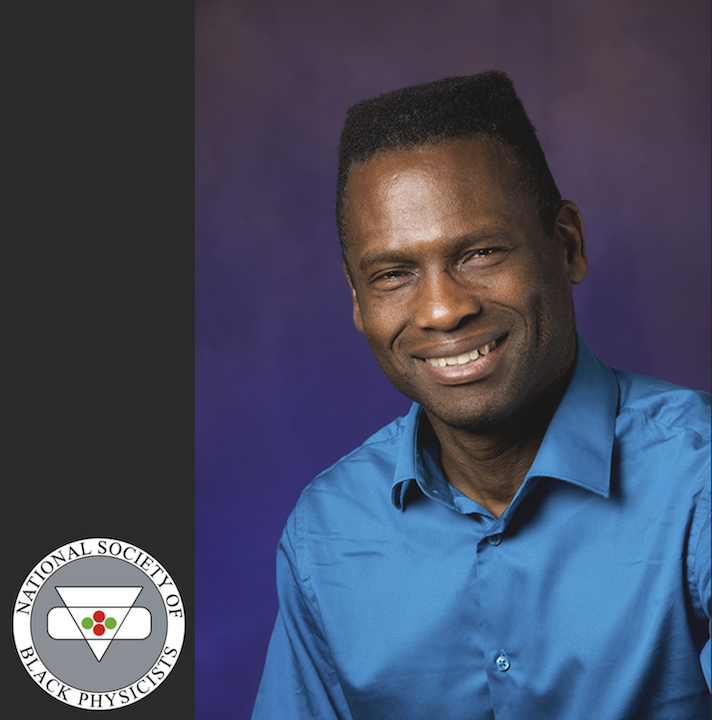
Prof. Philip Phillips
Professor, University of Illinois at Urbana-ChampaignBeyond BCS Theory: Exact Model for Superconductivity and Mottness
High-temperature superconductivity in the cuprates remains an unsolved problem because the cuprates start off their lives as Mott insulators in which no organizing principle such a Fermi surface can be invoked to treat the electron interactions. Consequently, it would be advantageous to solve even a toy model that exhibits both Mottness and superconductivity. In 1992 Hatsugai and Khomoto wrote down a momentum-space model for a Mott insulator which is safe to say was largely overlooked, their paper garnering just 21 citations (6 due to our group). I will show exactly[1] that this model when appended with a weak pairing interaction exhibits not only the analogue of Cooper's instability but also a superconducting ground state, thereby demonstrating that a model for a doped Mott insulator can exhibit superconductivity. The properties of the superconducting state differ drastically from that of the standard BCS theory. The elementary excitations of this superconductor are not linear combinations of particle and hole states but rather superpositions of doublons and holons, composite excitations signaling that the superconducting ground state of the doped Mott insulator inherits the non-Fermi liquid character of the normal state. Additional unexpected features of this model are that it exhibits a superconductivity-induced transfer of spectral weight from high to low energies and a suppression of the superfluid density as seen in the cuprates.[1] https://www.nature.com/articles/s41567-020-0988-4.
About the Speaker
Professor Philip Phillips received his bachelor's degree from Walla Walla College in 1979, and his Ph.D. from the University of Washington in 1982. After a Miller Fellowship at Berkeley, he joined the faculty at Massachusetts Institute of Technology (1984-1993). Professor Phillips came to the University of Illinois in 1993. Professor Phillips is a theoretical condensed matter physicist who has an international reputation for his work on transport in disordered and strongly correlated low-dimensional systems. He is the inventor of various models for Bose metals, Mottness, and the random dimer model, which exhibits extended states in one dimension, thereby representing an exception to the localization theorem of Anderson's.Thursday, August 27, 2020 at 5:30 PM EST


Delilah Gates
Ph.D candidate at Harvard University Physics and member of the Center for the Black Hole InitiativeObservable Blueshift from Circular Equatorial Orbiters around Kerr Black Holes
With the success of the Event Horizon Telescope, identifying new observational signatures of black holes are of increasing interest. In this talk we investigate blueshift of photons from an equatorial accretion disk of emitters orbiting on stable circular orbits terminating at the ISCO.We analytically calculate the blueshift of photons that escape to the celestial sphere (instead of falling into the black hole) and numerically calculate the maximum blueshift received by an observer at fixed angle on the celestial sphere.
About the Speaker
Delilah Gates is a graduate student in Prof. Andrew Strominger’s group studying observational signatures of high-spin black holes and near-horizon near extreme limits related to the emergent near-horizon conformal symmetry of the Kerr black hole solution.Tuesday, July 21, 2020 at 1:00 PM EST

